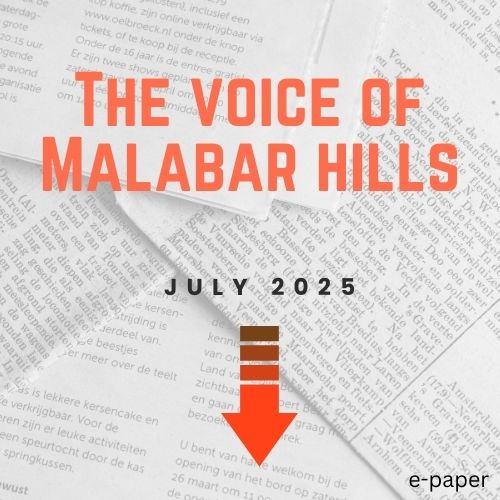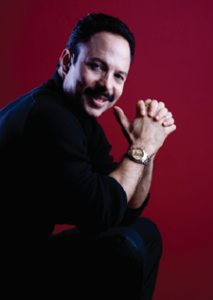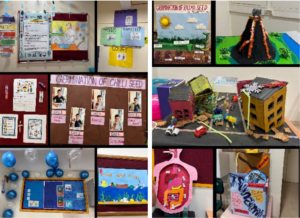In 1991 a plan was submitted to the Municipal Corporation of Greater Mumbai for the Banganga Tank to meet the same fate as the others which were lost to the city – fill up and build more and more high-rises under the guise of development. A few likeminded residents on the Hills persuaded the then Municipal Commissioner Mr. K. Padmanabiah to save this historic site, which was the only one fed by underground stream, the ‘Bhogawati’.
The first task was to bring awareness and then move citizens of Mumbai to value this heritage. To carry it forward to future generations. A ‘Banganga Conservation Committee’ was formed under chairmanship of Mr. Padmanabiah and Mrs. Anita Garware as Convenor. Various authorities in the city, like the Collector, Police, and the Government of Maharashtra’s Departments of Archaelogy, Culture, Tourism etc. were invited to become members. At the very first meeting the decision was to make people aware of its existence, and not just a name bandied about and lost to legend. Thus was born the idea of using ‘Live Music to Save Heritage’ – the ‘Banganga Festival’.
1st step – to bring awareness of the site.
Maharashtra Tourism Development Corporation (MTDC), under the leadership of Mr. Devrath Mehta, accepted the responsibility of organising such a 2-nights extravaganza in January 1992. However a lot of work had to be done beforehand by various authorities. Surveys were conducted, which revealed some horrifying facts!
There were problems galore as the Tank was the property of the GoudS araswat Brahmin Trust, but the Department of Archealogy were the guardians of the same.Thus neither could be bothered!There were unauthorised encroachments, certain tenements and buildings had allowed their sewage lines to flow into the tank, the steps around the tank were broken at several places, the water was dirty and a breeding ground for infections, the peripheral road had not been maintained, the steps leading down from Ridge Road were unsafe, there was inadequate lighting, garbage bins had not been provided at specific locations and so on and on. Worst was the apathy and non-cooperation of local ‘representatives of the people’. Of course, like for all such events, the question was who would fund it? The Government was not willing, nor was any Indian corporate house willing to consider this. Foreign banks, with branches in India, were the only recourse as they were supporting heritage conservation efforts in other countries. GRINDLAYS, HSBC and CITIBANK jointly agreed to assist in this yet untried effort.
The authorities took on the mammoth task to meet the deadline of the Festival in 1992. MCGM cleaned and diverted the sewage lines and repaired the roads. BEST installed additional lights. The Department of Archealogy repaired the ‘Deepstambas’ marking the temples. Personnel attached to the Malabar Hill Police Station helped maintain discipline. A local resident, Mr. Rocky Crastro, personally dove into the Tank to open the valve installed by the Portuguese, allow the waters to flow to the Arabian Sea, and clean the stone floor. The enthusiasm of the authorities was amazing! They all ensured that on the weekend of 11th and 12th January, music and dance enthralled Mumbai at this marvellous site. Hema Malini performed on that Saturday and Ustad Amjad Ali Khan’s ‘Sarod’ created magic across the waters on Sunday.
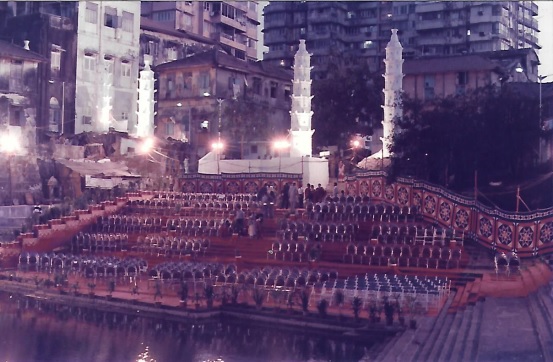
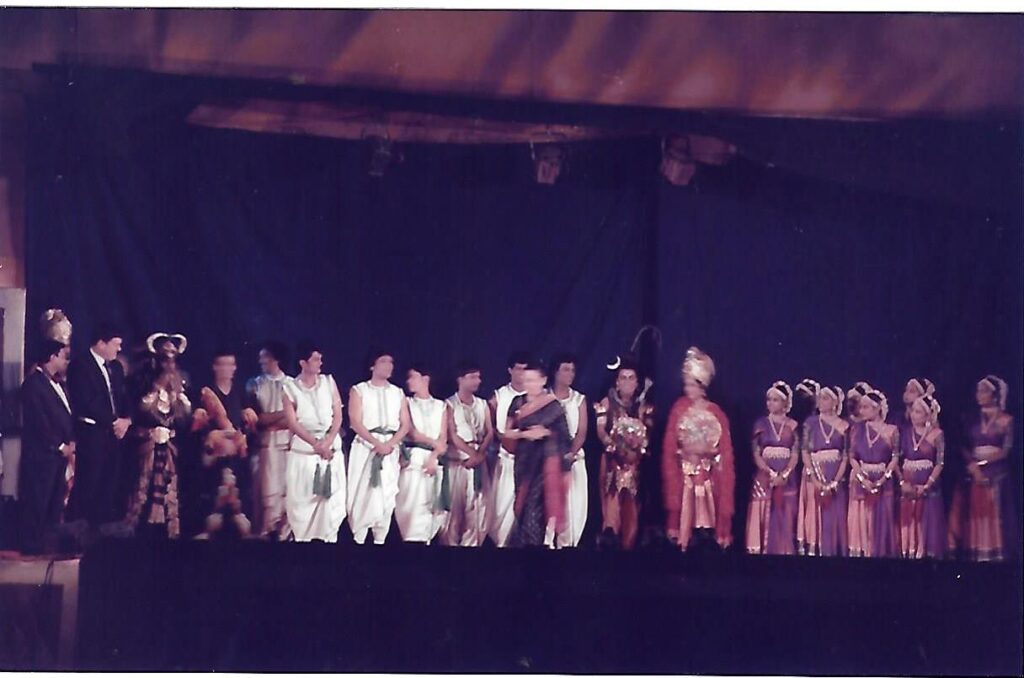
The 2-day Festival was a great success and the steps around were thronged with over 3,000 spectators. Mumbaikars demanded more, and so it continued on the 2nd weekend of January every year. World renowned artistes performed and the Festival gained in popularity across the nations. International media covered the events and it was the listed in Festivals of India to promote tourism.
The Festival continued till the Mumbai High Court Order of 2009 on Silence Zones within city limits, brought down the curtains as it was within 100 meters of places of worship. The Gods needed their rest according to the AWAZ FOUNDATION’s Public Interest Litigation.
Not to be defeated thus, IHS tried a different system of sound disbursal. Mr. Vikram Krishna suggested use of short-wave transmission. This was tried for 2 years with the assistance of PHILIPS (I) Ltd. They gifted 100 small transistors for amplification. These were placed on small stands around the tank. The first year the experiment was successful, though obviously not as good as with loudspeakers, but the following years, the organisers were petrified with the thought that a stampede would result in a major catastrophie! Some people in the audience considered themselves smarter than the technicians, fiddled with the buttons on the transistors, others started shouted because of this disturbance in reception – and then the crowds would have rushed out. Over 3000 persons, rushing and crushing out of the area up just 4 narrow stairways! Another Kumbh Mela in the making.
The only step forward was to move the location and continue to use ‘Live Music for Heritage’ at another heritage site. The Festival on the 2nd weekend of every year continues enthralling audiences outside the steps of the Town Hall. It continues as a much-awaited programme in the city. The new location brought a change of name as ‘Mumbai Sanskriti’and also a change of sponsors. HSBC has continued its support from inception and are joined by TCS
2nd step – Repairs, restoration & conservation.
The INDIAN HERITAGE SOCIETY (IHS) took the responsibility of moving forward to the next and more important step. Saving the Tank was not enough. It needed appreciation and care. Several meetings with the authorities involved with making the Development Control Rules for the city. These were very successful.
- The site was declared as a Heritage Precinct deserving special rules.
- The Tank, the peripheral road and one row of houses around it were protected.
- No development would be permitted without clearance by the Municipal Corporation’s Heritage Conservation Committee.
The site was of heritage value to all citizens to hold in trust. No religious significance was accorded. The temples
around, started as ghardehasars(family temples) of the settlers around the Tank, but over the years the doors were
opened to other believers. Even today the site has 14 temples. To name a few –Walkeshwar, Rameshwar, Ganapati, Parushuram, Vajareshwar, VenkateshBalaji. All needed repairs.
Rameshwar Temple
IHS selected the Rameshwar Temple as its first attempt.It stands on the western bank of the Tank.Its shikhara faced the worst ravages of the winds and the sea air. Its plaster had fallen off and the brickwork was exposed further to stress, resulting in leakages inside the sanctum sanctorum. Soon it would be beyond repair!

So out came the begging bowl again! This time filled most readily by Mr. NarrotamSekhsaria. He not only provided the necessary funds from the NARROTAM SEKHSARIA FOUNDATION, but also the expertise of his consultants in AMBUJA CEMENT. The work was entrusted to conservation architect Mr. Harshad Bhatia, who had initiated the conservation plan for this heritage precinct. With his expertise the temple soon shone white against the golden setting sun.
This existing Shiva temple was built in 1842 A.D., is cut in course stone masonry and owned by the Raghoba Jivaji Jayakar Trust. It has a stone ‘Nandi’(bull) guarding its entrance to the ‘garba-griha’ (sanctum sanctorum), with a stone ‘Kurma’ (tortoise) in front. The structure is a mix of Maratha & Gujarati architecture. The main shrine is marked by a brick tower of ‘nagara’ style, in lime mortar, over a hemispherical dome on the inside. Restoration work was done in phases from 2002 to 2005 as permissions from various authorities took time.

Ganapati Temple
The Jayakar Trust, were so happy with the restoration that they requested IHS to restore their Ganapati Temple across, on the edge of the Tank. Mr. Narrotam Sekhsaria once again supported the efforts and Mr. Rahul Chemburkar, Conservation Architect was contracted to oversee this work. This temple for Lord Ganesha, surrounded by beautiful wooden fretwork, was completed in 2007.
Venkatesh Balaji Temple
At the north-eastern corner of the Tank stands a beautiful temple for Lord Venkatesh Balaji. This temple has a different story to tell. To save it involved a long battle in courts of law, which lasted for nearly 10 years, from 1994 to 2007. Eventually the Mumbai High Court ordered the developer that only partial TDR could be utilised for the building at the back, but first he had to repair and restore the Temple to its original glory
The original idol of Lord Venkatesh was brought to Mumbai from Tirupati and the existing shrine built 225 years ago. The temple complex includes an adjacent ‘chawl’ to house the ‘pujari’ and others for it upkeep. Also housed is a ‘nagarkhana’ (place to store musical instruments).
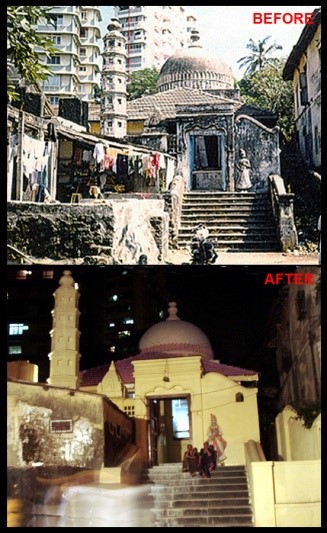
3rd step – a conservation plan for the whole precint.
Harshad Bhatia then presented a detailed conservation plan to the authorities. Roads, lighting, plumbing, development maintaining the character of the present buildings and respecting the scale of the Tank. It would allow for residents to have 21st century conveniences
The crematorium in the area could be developed to allow
- Electric cremation
- A collection facility and ghat(ramp) for emersion of ashes
- A hall for prayers
- A holistic involvement with the Tank
This plan was submitted in 1997 and the Municipal Corporation were agreeable to maintaining these new facilities if IHS could get support of the Shankersett Trust, which has the responsibility of looking after the present one. The Rotary Club of Bombay Midtown, under chairmanship of Late Mr. Suraj Sanghi, was willing to fund this total construction, but unfortunately failure was to gain support from residents and the Trust. Like so many stories in the city, the last twenty years has seen battles for power and domination, ignoring the needs of the residents of the area and the heritage value of this 12th century site.
Article by Anita Garware, Chairperson, Indian Heritage Society, resident of Malabar Hill. 
